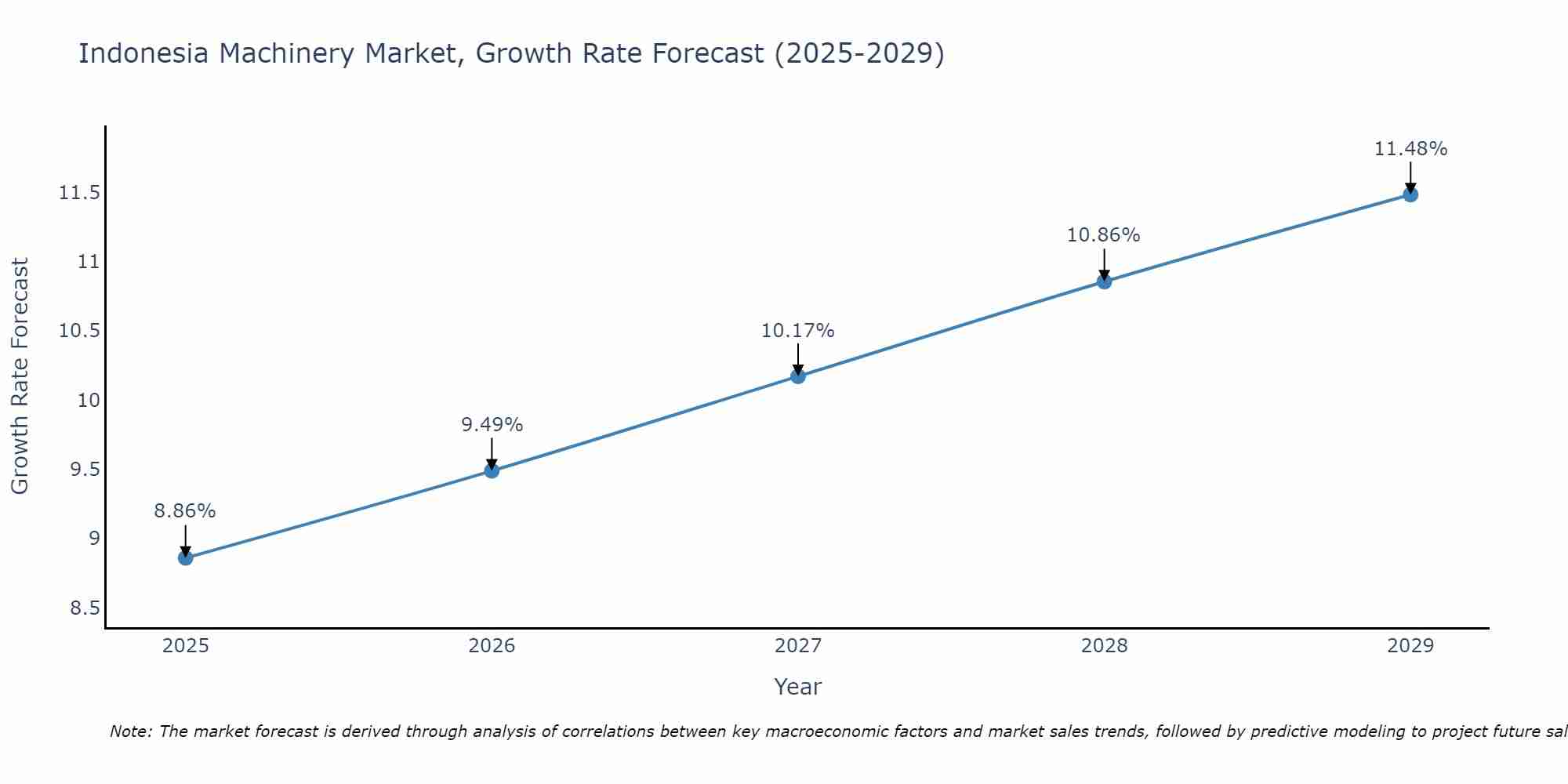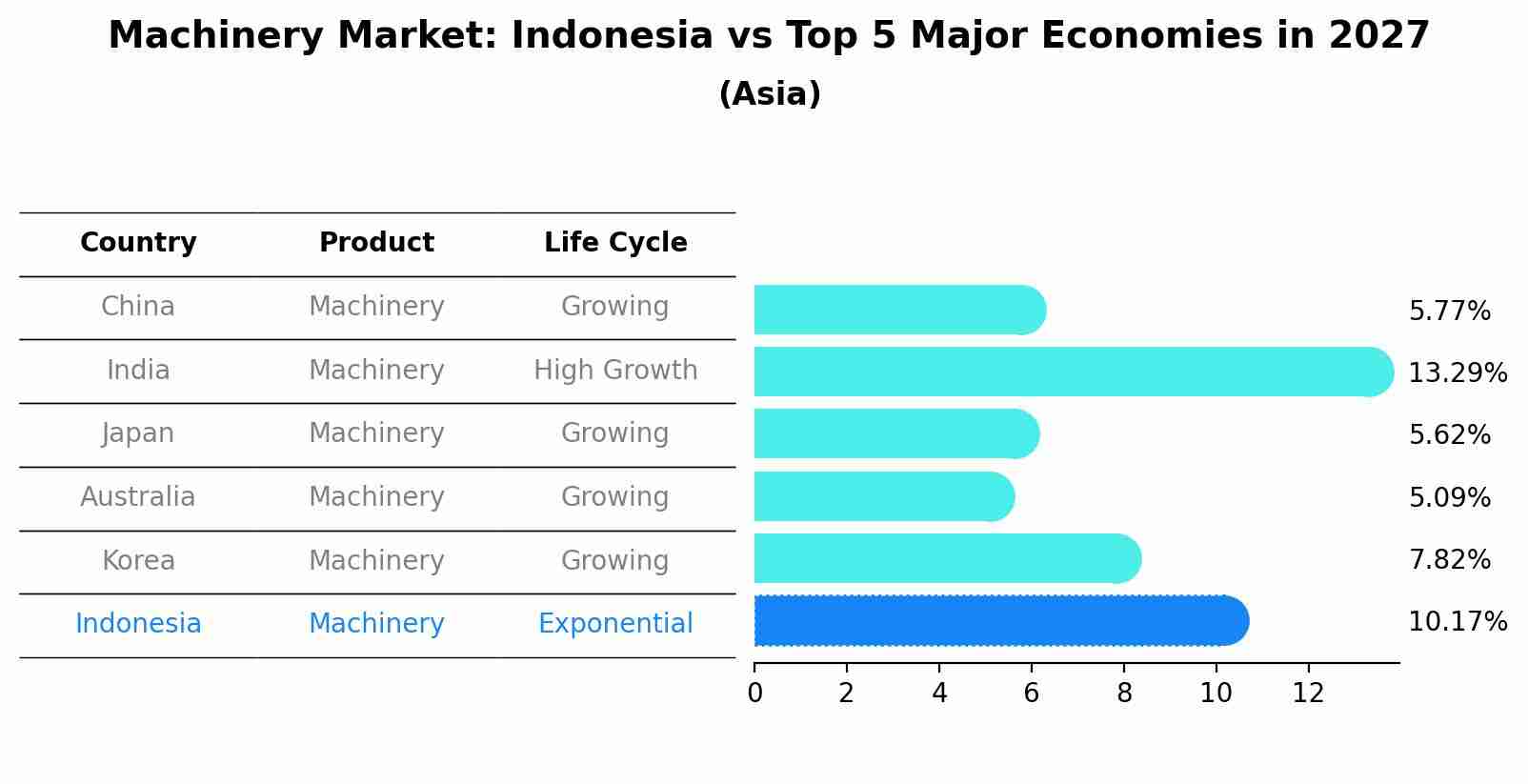Indonesia Machinery Market (2025-2031) Outlook | Share, Value, Companies, Growth, Industry, Forecast, Analysis, Size, Revenue, Trends
| Product Code: ETC433164 | Publication Date: Oct 2022 | Updated Date: Apr 2025 | Product Type: Market Research Report | |
| Publisher: 6Wresearch | Author: Ravi Bhandari | No. of Pages: 75 | No. of Figures: 35 | No. of Tables: 20 |
Indonesia Machinery Market Size Growth Rate
The Indonesia Machinery Market is likely to experience consistent growth rate gains over the period 2025 to 2029. The growth rate starts at 8.86% in 2025 and reaches 11.48% by 2029.

Machinery Market: Indonesia vs Top 5 Major Economies in 2027 (Asia)
The Machinery market in Indonesia is projected to grow at a high growth rate of 10.17% by 2027, highlighting the country's increasing focus on advanced technologies within the Asia region, where China holds the dominant position, followed closely by India, Japan, Australia and South Korea, shaping overall regional demand.

Indonesia Machinery Market Synopsis
The Indonesia machinery market is a pivotal sector in the country`s industrial landscape, playing a vital role in manufacturing and construction activities. With Indonesia`s consistent economic growth and infrastructure development, the demand for machinery has been on the rise. Key factors contributing to the market`s growth include urbanization, government initiatives to boost manufacturing, and the expansion of various industries such as agriculture, mining, and construction. As a result, both domestic and international machinery manufacturers are actively participating in this market, offering a wide range of products from heavy machinery to specialized equipment catering to specific industry needs. Moreover, advancements in technology, such as automation and artificial intelligence, are driving the adoption of modern machinery solutions, enhancing efficiency and productivity across sectors. With Indonesia`s continued development, the machinery market is poised for substantial growth in the foreseeable future.
Drivers of the Market
The Indonesia Machinery market is influenced by several driving factors. Firstly, the country`s expanding industrial and manufacturing sectors require a wide range of machinery for production, processing, and packaging purposes. This includes machinery for agriculture, construction, textiles, and food processing. Secondly, government initiatives to promote domestic manufacturing and reduce import dependence have led to increased investments in machinery and manufacturing facilities. Thirdly, advancements in technology, automation, and Industry 4.0 concepts drive the demand for modern and efficient machinery. Additionally, the growth of the construction and infrastructure development sector necessitates heavy machinery such as excavators, cranes, and bulldozers, further contributing to market growth.
Challenges of the Market
The Indonesia Machinery market is confronted with various challenges. Firstly, there can be regulatory hurdles related to import/export, safety standards, and environmental regulations that impact the machinery industry. Secondly, technological advancements require continuous investments in research and development, posing financial constraints for some companies. Additionally, competition from international manufacturers and fluctuating global commodity prices can affect market dynamics.
COVID-19 Impact on the Market
The machinery market faced disruptions in supply chains and manufacturing activities during the pandemic. Many industries postponed or canceled their capital expenditure plans, leading to a decline in demand for machinery. However, with the government`s efforts to stimulate economic growth and infrastructure development, the machinery market is gradually regaining momentum.
Key Players in the Market
In the Indonesia machinery market, key players consist of manufacturers, distributors, and service providers across various industries. Companies like PT. United Tractors Tbk are significant contributors, supplying heavy machinery for construction, mining, and agriculture, driving the country`s infrastructure and industrial development.
Key Highlights of the Report:
- Indonesia Machinery Market Outlook
- Market Size of Indonesia Machinery Market, 2024
- Forecast of Indonesia Machinery Market, 2031
- Historical Data and Forecast of Indonesia Machinery Revenues & Volume for the Period 2021-2031
- Indonesia Machinery Market Trend Evolution
- Indonesia Machinery Market Drivers and Challenges
- Indonesia Machinery Price Trends
- Indonesia Machinery Porter's Five Forces
- Indonesia Machinery Industry Life Cycle
- Historical Data and Forecast of Indonesia Machinery Market Revenues & Volume By Type for the Period 2021-2031
- Historical Data and Forecast of Indonesia Machinery Market Revenues & Volume By Agriculture, Construction, And Mining Machinery for the Period 2021-2031
- Historical Data and Forecast of Indonesia Machinery Market Revenues & Volume By Industrial Machinery for the Period 2021-2031
- Historical Data and Forecast of Indonesia Machinery Market Revenues & Volume By Commercial And Service Industry Machinery for the Period 2021-2031
- Historical Data and Forecast of Indonesia Machinery Market Revenues & Volume By Ventilation for the Period 2021-2031
- Historical Data and Forecast of Indonesia Machinery Market Revenues & Volume By Heating for the Period 2021-2031
- Historical Data and Forecast of Indonesia Machinery Market Revenues & Volume By Air-Conditioning for the Period 2021-2031
- Historical Data and Forecast of Indonesia Machinery Market Revenues & Volume By Commercial Refrigeration Equipment for the Period 2021-2031
- Historical Data and Forecast of Indonesia Machinery Market Revenues & Volume By Distribution Channel for the Period 2021-2031
- Historical Data and Forecast of Indonesia Machinery Market Revenues & Volume By Supermarkets/Hypermarkets for the Period 2021-2031
- Historical Data and Forecast of Indonesia Machinery Market Revenues & Volume By Convenience Stores for the Period 2021-2031
- Historical Data and Forecast of Indonesia Machinery Market Revenues & Volume By E-Commerce for the Period 2021-2031
- Historical Data and Forecast of Indonesia Machinery Market Revenues & Volume By Others for the Period 2021-2031
- Historical Data and Forecast of Indonesia Machinery Market Revenues & Volume By Others for the Period 2021-2031
- Historical Data and Forecast of Indonesia Machinery Market Revenues & Volume By Nature for the Period 2021-2031
- Historical Data and Forecast of Indonesia Machinery Market Revenues & Volume By Organic for the Period 2021-2031
- Historical Data and Forecast of Indonesia Machinery Market Revenues & Volume By Conventional for the Period 2021-2031
- Indonesia Machinery Import Export Trade Statistics
- Market Opportunity Assessment By Type
- Market Opportunity Assessment By Distribution Channel
- Market Opportunity Assessment By Nature
- Indonesia Machinery Top Companies Market Share
- Indonesia Machinery Competitive Benchmarking By Technical and Operational Parameters
- Indonesia Machinery Company Profiles
- Indonesia Machinery Key Strategic Recommendations
Frequently Asked Questions About the Market Study (FAQs):
- Single User License$ 1,995
- Department License$ 2,400
- Site License$ 3,120
- Global License$ 3,795
Search
Thought Leadership and Analyst Meet
Our Clients
Related Reports
- Afghanistan Apparel Market (2026-2032) | Growth, Outlook, Industry, Segmentation, Forecast, Size, Companies, Trends, Value, Share, Analysis & Revenue
- Canada Oil and Gas Market (2026-2032) | Share, Segmentation, Value, Industry, Trends, Forecast, Analysis, Size & Revenue, Growth, Competitive Landscape, Outlook, Companies
- Germany Breakfast Food Market (2026-2032) | Industry, Share, Growth, Size, Companies, Value, Analysis, Revenue, Trends, Forecast & Outlook
- Australia Briquette Market (2025-2031) | Growth, Size, Revenue, Forecast, Analysis, Trends, Value, Share, Industry & Companies
- Vietnam System Integrator Market (2025-2031) | Size, Companies, Analysis, Industry, Value, Forecast, Growth, Trends, Revenue & Share
- ASEAN and Thailand Brain Health Supplements Market (2025-2031) | Strategy, Consumer Insights, Analysis, Investment Trends, Opportunities, Growth, Size, Share, Industry, Revenue, Segments, Value, Segmentation, Supply, Forecast, Restraints, Outlook, Competition, Drivers, Trends, Demand, Pricing Analysis, Competitive, Strategic Insights, Companies, Challenges
- ASEAN Bearings Market (2025-2031) | Strategy, Consumer Insights, Analysis, Investment Trends, Opportunities, Growth, Size, Share, Industry, Revenue, Segments, Value, Segmentation, Supply, Forecast, Restraints, Outlook, Competition, Drivers, Trends, Demand, Pricing Analysis, Competitive, Strategic Insights, Companies, Challenges
- Europe Flooring Market (2025-2031) | Outlook, Share, Industry, Trends, Forecast, Companies, Revenue, Size, Analysis, Growth & Value
- Saudi Arabia Manlift Market (2025-2031) | Outlook, Size, Growth, Trends, Companies, Industry, Revenue, Value, Share, Forecast & Analysis
- Uganda Excavator, Crane, and Wheel Loaders Market (2025-2031) | Strategy, Consumer Insights, Analysis, Investment Trends, Opportunities, Growth, Size, Share, Industry, Revenue, Segments, Value, Segmentation, Supply, Forecast, Restraints, Outlook, Competition, Drivers, Trends, Demand, Pricing Analysis, Competitive, Strategic Insights, Companies, Challenges
Industry Events and Analyst Meet
Whitepaper
- Middle East & Africa Commercial Security Market Click here to view more.
- Middle East & Africa Fire Safety Systems & Equipment Market Click here to view more.
- GCC Drone Market Click here to view more.
- Middle East Lighting Fixture Market Click here to view more.
- GCC Physical & Perimeter Security Market Click here to view more.
6WResearch In News
- Doha a strategic location for EV manufacturing hub: IPA Qatar
- Demand for luxury TVs surging in the GCC, says Samsung
- Empowering Growth: The Thriving Journey of Bangladesh’s Cable Industry
- Demand for luxury TVs surging in the GCC, says Samsung
- Video call with a traditional healer? Once unthinkable, it’s now common in South Africa
- Intelligent Buildings To Smooth GCC’s Path To Net Zero


















